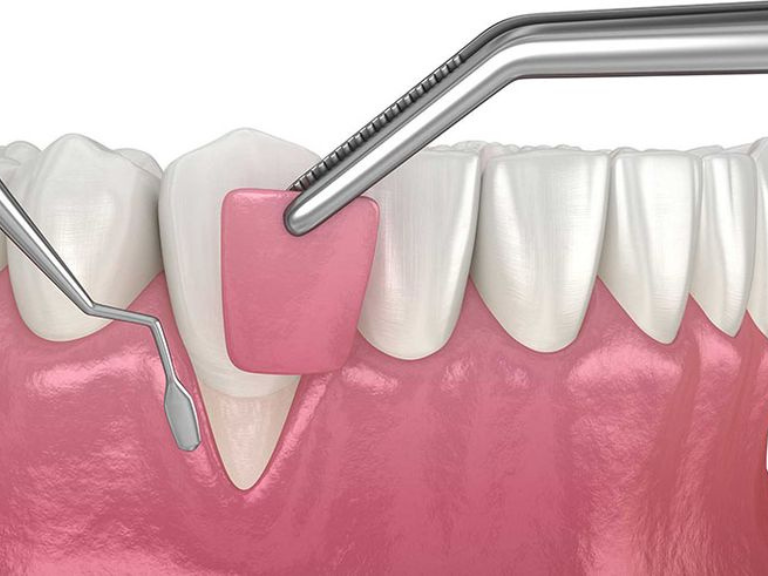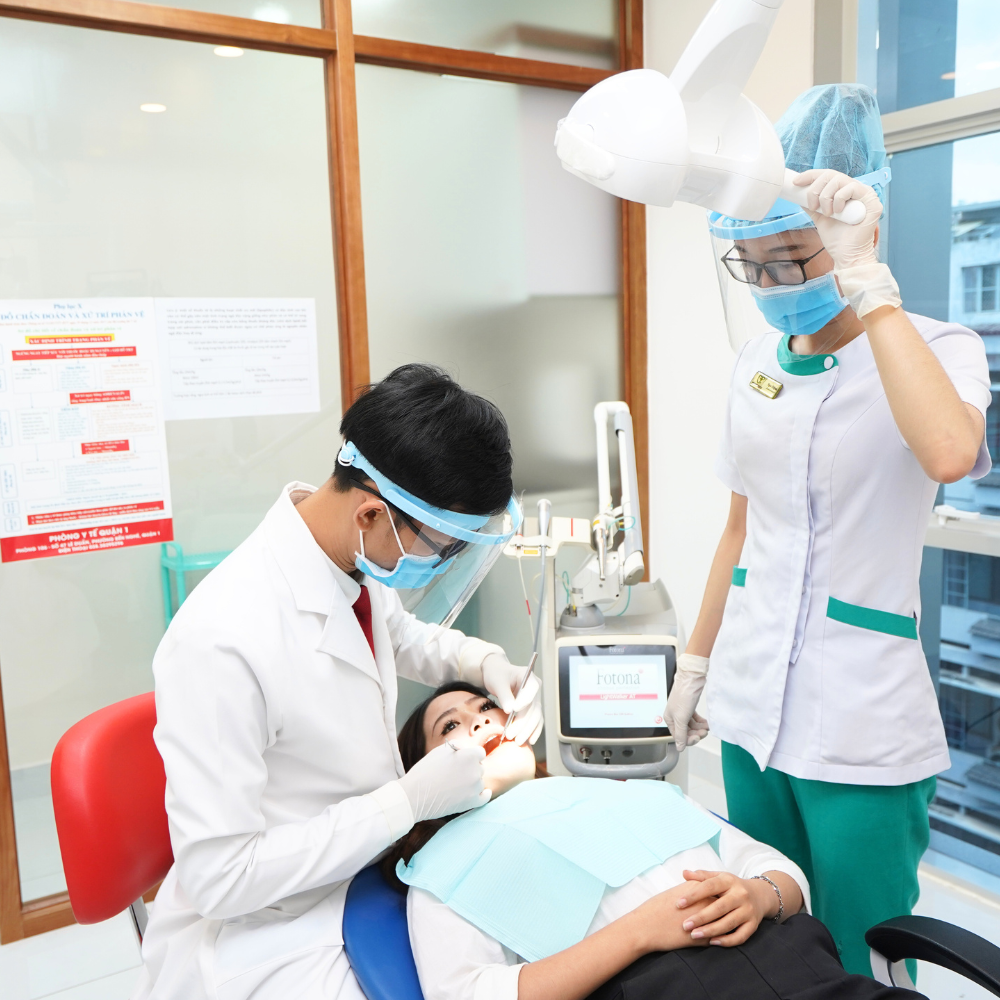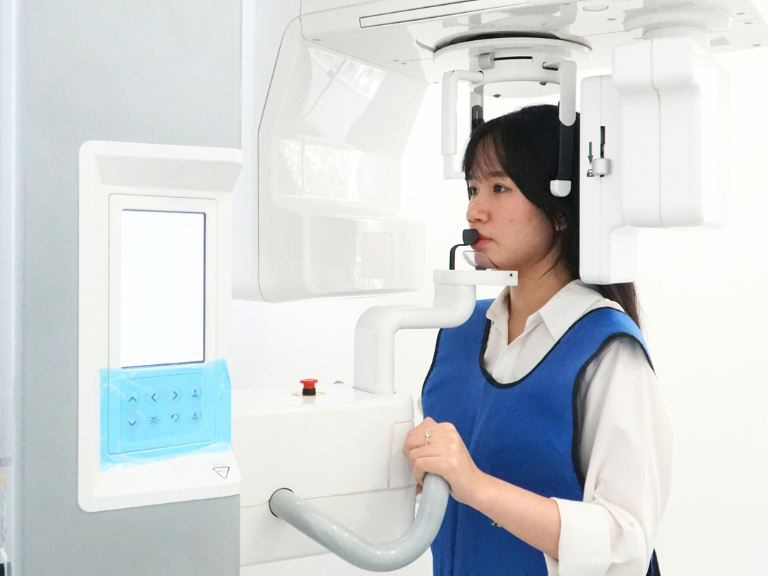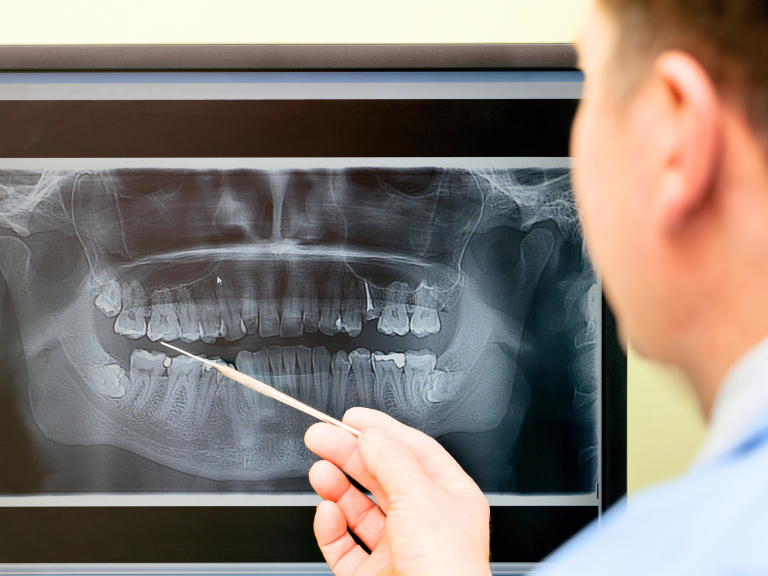Gum surgery (also known as periodontal surgery) is a dental procedure that removes excess or damaged gum tissue. Periodontists often use this method to treat periodontal disease or to improve the aesthetics of a smile. Recovery after gum surgery usually takes about a week and provides long-lasting results.
1. What is Gum Surgery?
Gum surgery is a dental procedure performed to treat gum diseases or to improve the aesthetic appearance of a smile.
Purpose of Gum Surgery:
- Treating Periodontal Disease:
+ Removing damaged or inflamed gum tissue: This helps reduce harmful bacteria and cleans periodontal pockets (deep spaces between the teeth and gums) where bacteria can accumulate.
+ Regenerating bone and soft tissue: In severe cases of periodontal disease, surgery may be performed to regenerate lost or damaged bone and gum tissue.
- Improving Smile Aesthetics:
+ Gum contouring to lengthen tooth crowns: Applied in cases of excessive gum growth (gingival hypertrophy) or when teeth appear short due to excessive gum coverage, leading to a “gummy smile.” This surgery helps balance the gums and teeth for a more harmonious smile.
+ Gum grafting: Treats gum recession, where the tooth roots are exposed due to receding gums. The dentist will take gum tissue from another area of the mouth (usually the palate) to cover the exposed root, protecting the tooth, reducing sensitivity, and improving aesthetics.
+ Correcting uneven gum lines: Helps create a more balanced gum line around the teeth.

2. Common Gum Surgery Procedures
Common gum surgery procedures include:
- Traditional gum surgery (scalpel): The dentist uses a scalpel to remove excess gum tissue. This may sometimes be combined with adjusting a portion of the bone beneath the gum.
- Laser gum surgery: Uses a laser to remove gum tissue. This method often results in less bleeding, less pain, and faster recovery time.
Gum surgery is generally a relatively safe minor procedure and does not affect the structure of healthy teeth. However, any surgery carries small risks such as bleeding or infection, and recovery time can extend up to about a week depending on the type of surgery.
3. Should You Undergo Gum Surgery?
Whether or not to undergo gum surgery depends on your specific oral health condition and your goals. Gum surgery is not always necessary, but in many cases, it offers significant benefits.
Gum surgery is often recommended in two main situations:
- Treating severe gum disease:
+ Advanced periodontitis: If you have severe gingivitis or periodontitis, where bacteria have deeply penetrated the gum pockets (spaces between teeth and gums), causing damage to soft tissues and supporting bone, gum surgery helps deeply clean, remove bacteria and diseased tissue, and regenerate lost tissues. This helps stop disease progression, reduces the risk of tooth loss, and improves overall oral health.
+ Gum recession: When gums recede, exposing the tooth roots, leading to tooth sensitivity and an increased risk of root decay. Gum grafting can help cover the exposed root, protecting the tooth and improving aesthetics.
+ Medication-induced or pathological gingival enlargement: Certain medications or health conditions can cause excessive gum growth, making oral hygiene difficult and affecting aesthetics.
- Improving smile aesthetics:
+ Gummy smile: This is a condition where too much gum tissue is exposed when smiling, creating an unbalanced smile. Gum contouring surgery (often crown lengthening) removes excess gum, making teeth appear longer and more balanced.
+ Uneven gum line: Gum shaping surgery can adjust the gum line to make it more symmetrical and harmonious with the teeth.

4. Are There Risks Associated with Gum Surgery?
Gum surgery, although a minor procedure, carries potential risks like any medical procedure. However, it is generally considered a safe procedure with minimal danger when performed by a qualified dentist at a reputable dental facility.
Below are the potential risks and complications, along with ways to minimize them:
Potential Risks and Complications:
+ Severity: This is almost certainly going to occur after surgery, but it is usually mild to moderate.
+ Solution: Your dentist will prescribe pain relievers and anti-inflammatory drugs to help control these symptoms. They usually subside after a few days.
+ Severity: A small amount of bleeding from the surgical site is normal. However, prolonged or excessive bleeding is abnormal.
+ Cause: Could be due to incorrect surgical technique or a patient having blood clotting issues.
+Solution: Follow your dentist’s instructions on how to control bleeding and contact them immediately if bleeding does not stop.
+ Severity: A potential risk if sterilization is not ensured or post-surgical care is inadequate.
+ Symptoms: Increased redness, pain, pus, or fever.
+ Solution: Have the surgery performed at a reputable clinic that ensures sterility. Follow your dentist’s instructions for oral hygiene (antibacterial mouthwash, take antibiotics if prescribed).
- Tooth sensitivity (tenderness):
+ Severity: Can be temporary or prolonged, especially when surgery exposes part of the tooth root (e.g., in crown lengthening or gum grafting).
+ Solution: Use toothpaste for sensitive teeth, avoid overly hot/cold or acidic foods. This condition usually improves over time.
- Nerve or blood vessel damage (very rare):
+ Severity: Extremely rare but a serious complication. Can cause permanent numbness or loss of sensation in a specific area.
+ Cause: Due to an inexperienced dentist or incorrect technique.
- Unsatisfactory aesthetic results:
+ Severity: Can occur if gum calculation and shaping are imprecise, leading to an uneven gum line, or recurrence of a gummy smile.
+ Solution: Choose an experienced and highly specialized dentist who can accurately analyze and plan the treatment.
- Reaction to anesthesia (very rare):
+ Severity: Allergic reaction or anaphylactic shock to anesthesia, though rare, can be life-threatening.
+ Solution: Inform your dentist about any history of drug allergies (if any).
- 5. Post-Gum Surgery Care Instructions
Proper care after gum surgery is crucial for a smooth healing process, minimizing pain, and preventing complications. Here are detailed instructions on how to care for yourself after gum surgery:
Pain and Swelling Control
- Take medication as prescribed: Your dentist will prescribe pain relievers (e.g., Paracetamol, Ibuprofen) and antibiotics (if needed) to prevent infection. Take your medication exactly as directed, even if you feel better.
- Apply a cold compress: For the first 24-48 hours, apply an ice pack or cold cloth to the outside of your cheek, directly over the surgical area. Apply for 15-20 minutes, then rest for 15-20 minutes. This helps reduce swelling and bruising.
- Control bleeding: A little oozing of blood is normal. If bleeding occurs, place a clean, damp gauze pad over the surgical area and bite down gently, holding for about 20-30 minutes. Avoid forceful spitting.
Dietary Regimen
- Eat soft, liquid foods: For the first few days after surgery, prioritize soft, easy-to-swallow foods such as cool soup, porridge, yogurt, smoothies, ice cream, eggs, and steamed fish. Avoid hard, chewy, crispy foods: Nuts, potato chips, and hard bread can damage the surgical area.
- Avoid overly hot or cold, spicy, or acidic foods: Temperature and spicy/acidic flavors can cause irritation and pain.
Chew on the opposite side: Try to chew with the jaw on the non-surgical side to avoid direct impact on the healing area.
- Do not use a straw: Sucking can create negative pressure in the mouth, dislodging blood clots and causing bleeding.
- Avoid alcohol and tobacco: Alcohol and tobacco hinder the healing process, increasing the risk of infection and complications. You should abstain completely for at least a few weeks after surgery.
Oral Hygiene
- Do not brush the surgical area for the first 24 hours: Avoid brushing directly on the recently operated gum area for at least 24 hours, or as specifically instructed by your dentist.
- Brush gently: Afterwards, use a soft-bristled toothbrush and brush gently in other areas. Avoid touching the surgical site.
- Rinse with saline solution or antiseptic mouthwash: Your dentist may ask you to rinse gently with warm salt water or an antiseptic solution (like Chlorhexidine) starting from the second day after surgery. Rinse gently, do not rinse too vigorously to avoid dislodging blood clots or grafts (if any).
- Absolutely do not use toothpicks or dental floss: Avoid using toothpicks or dental floss in the surgical area until approved by your dentist.
Activity Restriction
- Get plenty of rest: Rest a lot on the first day after surgery. Avoid strenuous activities, bending over, or lifting heavy objects for the first few days.
- Avoid heavy exercise: Strenuous activity can increase blood pressure and cause bleeding. You should avoid heavy exercise for at least 1 week.








